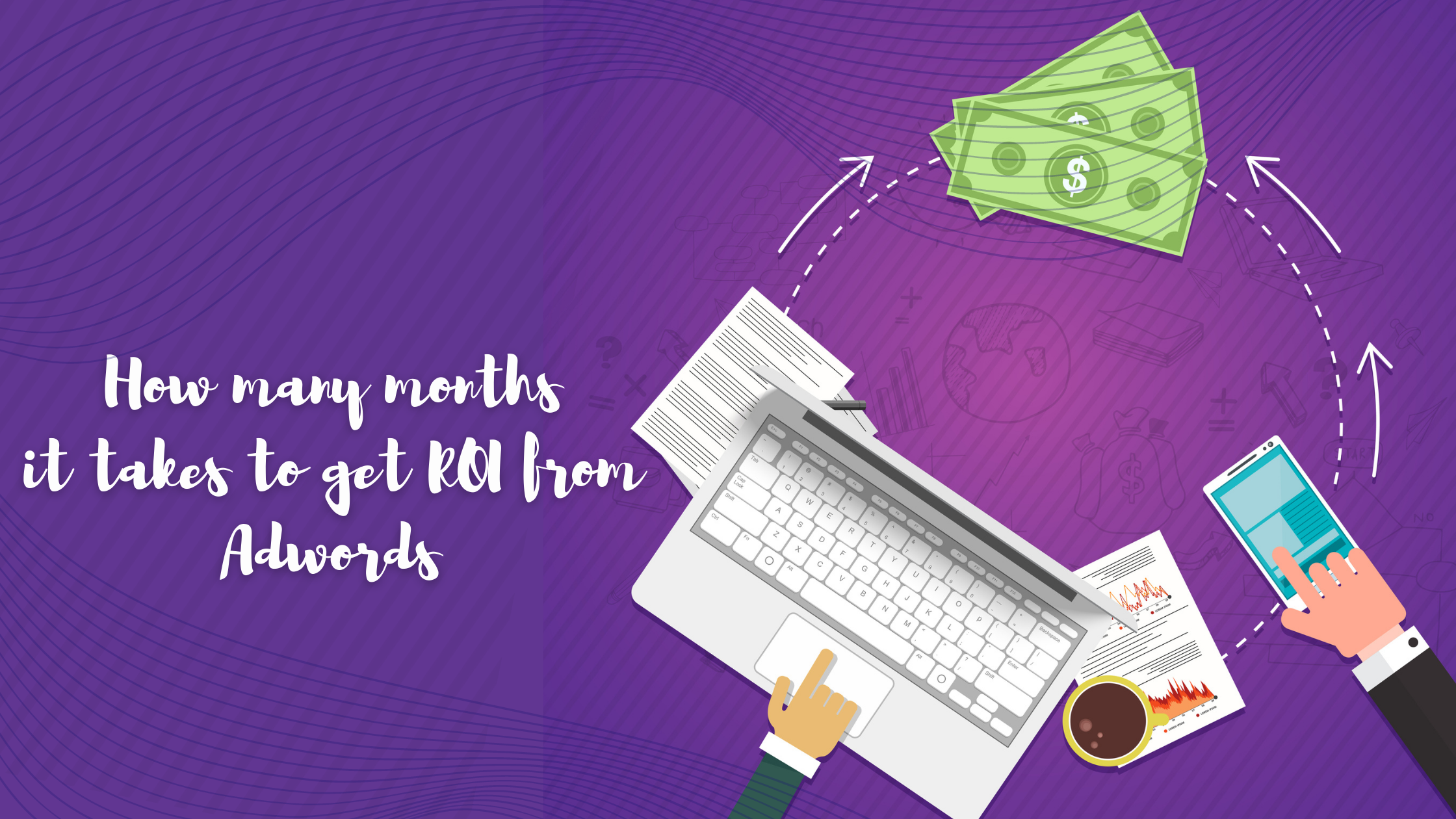
How Many Months it Takes to get ROI from Adwords

Advertising with Google Ads (formerly AdWords) is a great way of getting the word out about your business. Google Ads campaigns can be used to build brand awareness, generate leads and promote special offers. Campaigns can also be rolled out quickly and conversion rates are high for properly managed campaigns. But one question we get asked more than any other is, how long does it take to see results with Google Ads?
Google Ads (formerly Google AdWords) is excellent for attracting “ready to buy” leads and bringing you red-hot customers for your products or services. Conversion rates are relatively high, and a rock-solid campaign with Google Ads management can deliver sales to your business faster than other tactics.
However, getting the real revenue-busting results everyone raves about takes time. So, the question is… How long does it take for AdWords to work?
Timelines vary per business. Our years of experience managing ad campaigns for small businesses and enterprises alike mean we recommend:
- At least 3 months to mature a campaign
- 3-12 months to develop a strong campaign
Depending on the level of demand for your keywords, we would usually expect to start seeing impressions and click data in the first day of running ads. Generating leads or conversions can be more difficult to predict but we would expect them to increase over time with continual optimisation.
We can provide an estimated number of conversions based on industry metrics and the expected click through rate from your keywords. However, there are multiple factors that can affect conversion rate – these can include the product being sold, the ease and feel of your website, the offering of your competitors, your ad visibility and more.
But the results are worth it. Google AdWords is the most cost-effective advertising methods for companies of all sizes – from small shops to global enterprises.
While it definitely depends on a variety of factors including your type of business, your unique business goals and location(s), the competitiveness and search volume of your selected keywords, the ad copy and the landing page copy and experience, there is another answer.
It’s the time that it takes for Google’s algorithm to gather enough data and learn in addition to the time that it takes for you to make changes needed in order to optimize the campaign based on the data collected. Google Ads Can Work Immediately.
Google Ads can work immediately providing that:
- Your business is supplying a product/service that is relevant and competitive to your target market
- You’re working with an adequate marketing budget to give the market enough exposure to your business
- Know what you can pay for a lead, calculating the lifetime value your average customer
- Your Google Ads account is being managed efficiently and attentively
Google Ads Can Take Time
However, the first month of Google Ads is always going to be the most inefficient. So, if you’re seeing some results in your first month but not entirely happy – understand that a part of the process of optimising a Google Ads account is to collect data, refine the campaign and test those refinements. You must also take into account the commitment requirements and purchase cycle of your product/service. If approached correctly, PPC can bring fantastic results in a short amount of time, giving you a good boost in revenue alongside longer term inbound marketing work. At Global Vision Technology, our team of PPC specialists can work closely with you to get you the best results; to keep your CPA low and your ROI high.
Google Ads May Not Work for You
Depending on your business and the market that you serve, Google Ads may not be the right solution for your business. This is most common in B2B (business to business) industries (such as accounting) where networking, relationship building, and referrals are vital to earning the kind of trust that isn’t typically earned just from landing on a website. There is also the scenario where, due to such aggressive competition, the price of clicks on keywords relating to your business is simply too high to realistically compete. Another challenge is when you’re competing with big companies.
For example, if you’re up against a big company that offers electrical, plumbing and HVAC, when they’re bidding on keywords, they’re typically able to bid a lot higher and subsequently pay more per lead due to the fact that they’re able to sell multiple services to that one lead – essentially cutting the cost per lead into thirds. That makes it a lot harder for companies that offer just plumbing, just electrical or just HVAC services where they need to make profit off just one service per lead.
Or, Google Ads may not be the best way to access your target market.
Despite the rhetoric that old media such as radio and newspaper are dying, I simply couldn’t touch the results that those channels when I’ve run Google Ads for dentists or cruise companies, where the target audience is generally older.
Giving Yourself the Best Chance:
In the first scenario, we listed four conditions that were conducive to a successful and explosive outcome Google Ads. So, let’s dive a bit deeper into those four points and why they are so impactful on the performance of a Google Ads account.
1. Your Business
One thing come to mind here. “good products sell themselves”.
Or if we want to be a bit more sophisticated in our marketing speak – there are 4 P’s to a successful business:
- Product
- Price
- Placement
- Promotion
These 4 P’s are to do with advertising (Promotion). That means that what you sell, where you sell it and how much you sell it for contributes to 75% of a successful pitch to market with only 25% of it being down to marketing. Be honest with yourself and how appealing your product/service is to the market compared to what your competitors are offering.
2. Realistic Goals
Knowing what you’re willing to pay for a lead is vital to establishing realistic goals in Google Ads. When setting these realistic goals, you have to take into account the purchase cycle of a product/service and the lifetime value of that customer. You may not be in an industry where there is such a high-involvement in your customers’ purchase decision, yet the cost to acquire that client more or less destroys the profit you make in that initial job – that isn’t necessarily a bad result if you’re able to retain repeat business from that customer.
So, if you end up getting four jobs from that initial enquiry, the cost of that lead essentially goes down to 25% of the original cost when spread across the lifetime value of that customer.
3. Quality Score
Quality Score is Google’s rating of the quality and relevance of both your keywords and PPC ads. It is a score Google Ads provides as an indicator of how healthy an ad and keyword selection is and it partly goes towards determining the position of your ad. It is used to determine your cost per click (CPC) and multiplied by your maximum bid to determine your ad rank in the ad auction process. Your Quality Score depends on multiple factors, including:
- Your click-through rate (CTR).
- The relevance of each keyword to its ad group.
- Landing page quality and relevance.
- The relevance of your ad text.
- Your historical Google Ads account performance.
These are the core Quality Score components. No one outside of Google knows exactly how much each factor “weighs” in the Quality Score algorithm, but we do know that click-through rate is the most important component. When more people who see your ad click it, that’s a strong indication to Google that your ads are relevant and helpful to users. Accordingly, Google rewards you with:
- Higher ad rankings
- Lower costs
Generally speaking, the higher your Quality Score in Google Ads and Bing Ads, the lower your cost per conversion. Remember, a high-Quality Score is Google’s way of saying that your PPC ad meets your potential customers’ needs. The better you are at meeting the prospect’s needs, the less Google will charge you for the ad click.
4. Landing Page Optimisation
The page you send customers to after clicking your ad, commonly referred to as a landing page, can have a huge impact on your advertising effectiveness and budget. By optimizing landing page best practices, you’ll see your ad bid prices drop, users spending more time on your site, and hopefully more overall sales or leads generated. The Google Ads system evaluates landing pages on a regular basis and updates its assessment accordingly. In addition, your landing page experience also affects ad rank position, Quality Score, and overall cost. So, if your landing page is causing users to consistently leave without making a purchase, this may cause your ads to show less often, or even not at all.
The better tailored that your landing page is to a specific audience, the less likely they will be to click away, or bounce immediately. If you drive traffic to a general landing page instead a more relevant one, then you’re going to end up paying more for clicks and receive fewer conversions.
The more relevant your landing page is to your chosen keywords, the higher your Quality Score will be. Improve your Quality Score to get your ads ranked higher and the less you’ll need to pay per click.
Conclusion
If you take the time to research and select your keywords and location(s) carefully, set up the campaign in a way that best matches your goals, and create ads and landing pages that resonate with your audience, it will minimize the number of changes needed which will shorten the time that it takes to optimize your campaign and get results for your business.
Need help with your AdWords account? We’re happy to take a look. Request a quote today!



